The Best Meat Pies From Around The World
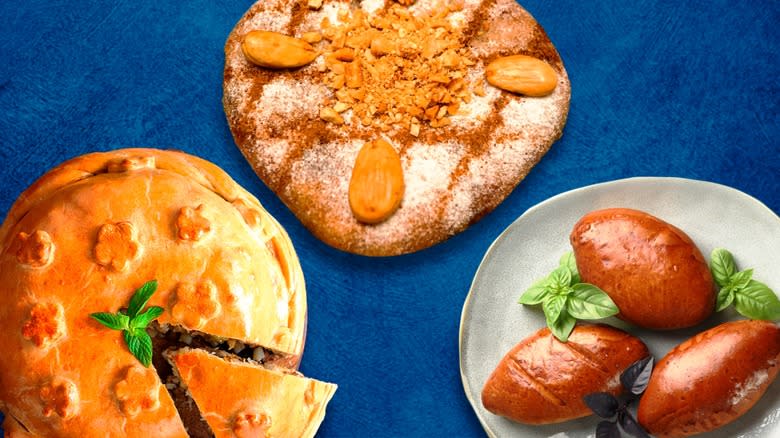
In the U.S., pie is often associated with fruit or custard-filled desserts covered in flaky pastry, but around the world, there are just as many meat pies as there are sweet ones. From Jamaica to Eastern Europe, cooks have been concocting savory, meat-filled pastries for centuries, narrowing in on specific flavors, ingredients, and presentations. Aside from classics like old-fashioned chicken pot pie and shepherd's pie, there's phyllo-covered b'stilla from Morrocco, a retro pâté-filled pie from France, and salty, juicy hand pies from China called xian bing.
As these recipes demonstrate, the definition of pie is broad. Loosely speaking, it's a dish that has a crust of some kind, but there is no definitive shape, filling, or type of pastry. Chilean pastel de choclo, for example, features a corn pudding topping instead of a wheat-based pastry shell, while timballo in Italy is made by encasing penne and ragú in a sheet of fresh pasta dough. Some of these recipes are easy to replicate at home while others take hours of work and attentive reading of the recipe. But whether you're looking for inspiration for your next get-together or simply want to travel the world through recipes, there's something for everyone (though vegetarians and vegans will have to make some ingredient adjustments).
Read more: Cuts Of Steak, Ranked Worst To Best
Torta De Frango (Brazil)
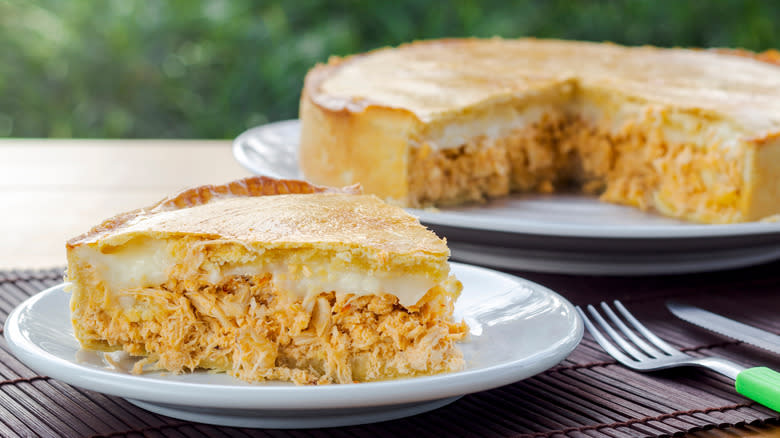
In Portuguese, the word "torta" means pie rather than cake, but torta de frango (chicken pie) falls somewhere in between the two. There are multiple ways to make the recipe, but the most common option involves batter rather than pastry dough. After making a relatively dry filling (more akin to what goes into a chicken enchilada filling than chicken pot pie), you make a smooth, cake-like batter with milk, eggs, flour, and baking powder. Half of it is poured into a cake tin or casserole dish, the filling is spooned on top, and the remaining half of the batter is poured over it. When the mixture cooks, the batter becomes light and bready, turning the dish into a savory cake with chicken in the center.
Another difference between torta de frango and many other meat-based pies is the consistency of the meat. Instead of dicing it into squares or letting it naturally fall apart during cooking, it's shredded into a mushy texture before being mixed with seasonings, chopped tomatoes, canned corn, and a creamy cheese spread called requejão. The result is a dense, moisture-rich cake that bears only a passing resemblance to pie.
Tourtiére (Quebec)
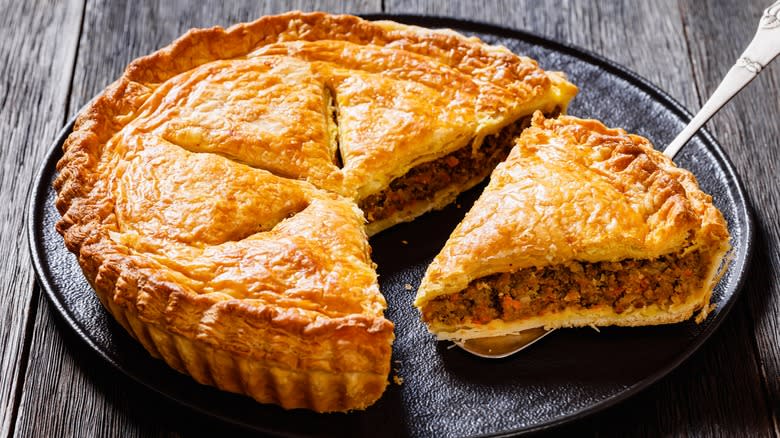
Quebec takes up just one geographical portion of Canada, but it has its own uniquely rich culture, language, and, of course, cuisine. In addition to the ubiquitous and delicious poutine, tourtiére is a prime example of Québécois food. The spiced meat pie is traditionally served around the winter holidays, especially as a late-night celebratory meal after midnight mass or on New Year's Eve. The crust is similar to the buttery ones you might find in chicken pot pie recipes, while the filling centers around ground pork and warming spices like cinnamon, nutmeg, mace, and cloves. Variations include everything from ground beef and venison to seafood.
Tourtiéres have been around since the 1600s when Québécois settlers celebrated the Christmas midnight mass with an opulent feast. The origin of the name is less clear. It either comes from the word "tourte," meaning the now-extinct passenger pigeon that once provided the meat used in the pie, or the type of pan employed to cook it. Although you can find tourtières at many supermarkets in Quebec, most fans of the dish would agree that it tastes infinitely better when it's made from scratch.
Karipap (Southeast Asia)
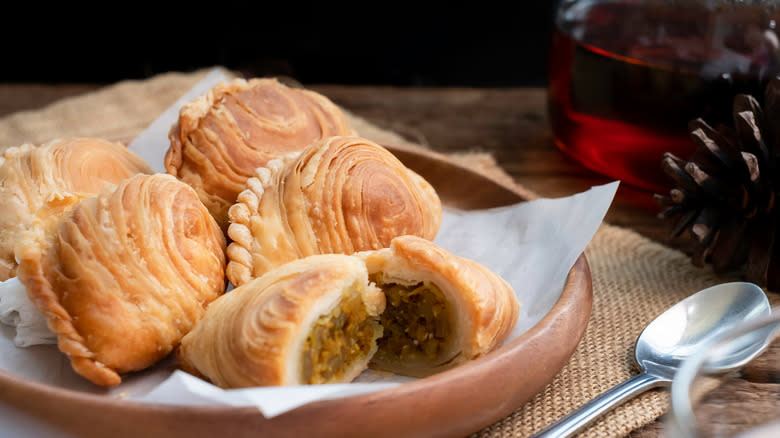
In the booming Southeast Asian street food scene, karipaps (also called curry puffs) are a standout treat. Made with flaky puff pastry, these small hand pies are filled with curried potatoes, onions, and meat, and are most commonly found in nations like Malaysia and Singapore. With their pastry buttery packaging and convenient serving size, they make an ideal lunch or afternoon snack, especially when you're too busy to sit down for a full meal. Although they bear a strong resemblance to empanadas, their crust is much thicker and flakier, providing a buttery crunch with every bite.
Luckily, curry puffs are simple to make. The easiest version only requires store-bought puff pastry, a curry spice blend such as garam masala, ground meat, potatoes, and aromatics like garlic and onions. The most traditional way of cooking karipaps is to fry them, but if you'd prefer to cut back on the oil, they can be baked as well.
Kurnik (Russia)
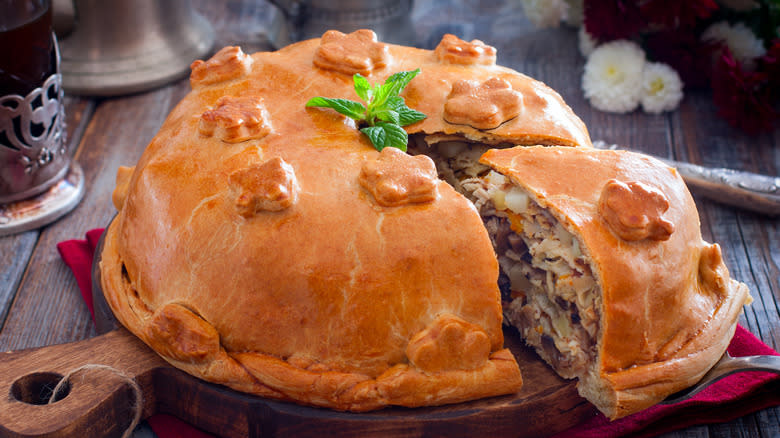
Russian food tends to be hearty, which is no surprise given the country's notoriously harsh climate. Kurnik, a version of chicken pot pie, is no exception, embracing substantial ingredients that will keep you warm and satiated on bitterly cold evenings. Made with chicken, rice, and hardboiled eggs, the filling is much heavier than American-style chicken pot pie, while the pastry varies from a single cover of puff pastry on the top to multiple tiers of pancake-like dough separating each layer of filling.
Kurnik is traditionally reserved for celebratory occasions like Easter. Although it can be made in a casserole dish or pie pan, one of the most popular and elegant options is to make a high, domed shape covered in intricate pastry designs. The pie was once a feature of weddings, where the families of the bride and groom would present their versions of the dish at the reception. Each side of the family decorated the crust with different pastry patterns to symbolize the masculine and feminine sides of the couple. These days, there's freedom in when and how to serve kurnik, but it will probably take a minimum of several hours to create, so make sure you set aside plenty of time if you decide to tackle it.
Kotopita (Greece)
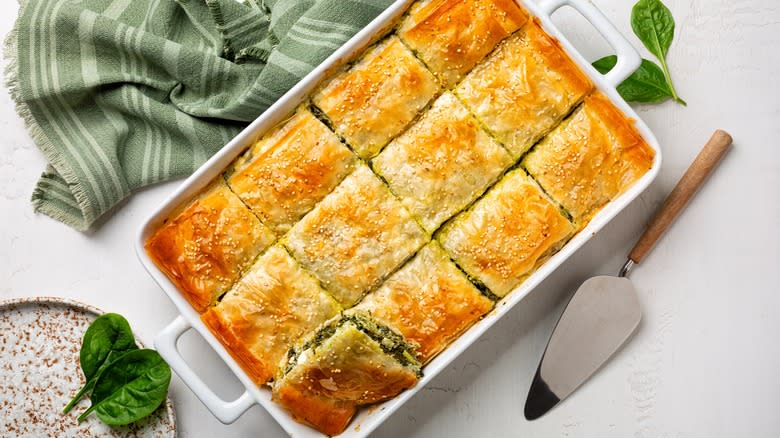
When it comes to Greek cuisine, baklava is just the tip of the pastry iceberg. Kotopita is the country's chicken pot pie counterpart, and it is just as buttery, flaky, and creamy as you could hope for. If you use store-bought phyllo, it also saves you the hassle of trying to make regular pie pastry from scratch. The filling is slightly different from the chicken pot pie as well, using bechamel sauce to heighten the velvety richness and cheese because, well, do you ever need a reason to add cheese?
To make kotopita, you'll need to roast and shred chicken breast meat or a whole chicken, caramelize onions, sauté your preferred veggies (though some recipes omit veggies entirely), and make the bechamel sauce with milk, flour, and butter. As for the cheese, opt for the hard Greek cheese kefalotyri if you can find it. Otherwise, pecorino romano or a mixture of your favorite hard cheeses will work. If you're feeling decadent, you can include ham and bacon as well. Once the filling and bechamel are prepared, layer several sheets of phyllo pastry into the bottom of a casserole dish, pour in the filling, and top it with more phyllo. To achieve a wispy, crunchy texture, make sure to brush each sheet liberally with melted butter.
B'stilla (Morrocco)
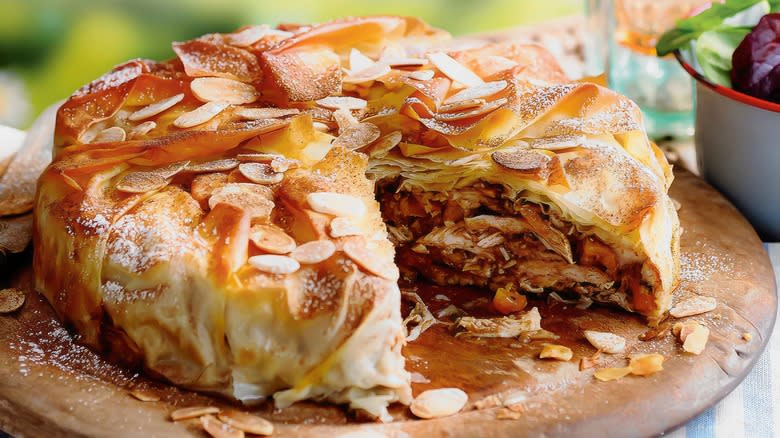
B'stilla (also called pastilla) is a Moroccan skillet chicken pie that bears some similarities to Greek kotopita. Made with phyllo dough instead of puff pastry or short-crust pastry, it is crispy on the outside and full of creamy filling. Unlike the Greek pie, however, b'stilla features a combination of powerful spices and sweet additions to make the dish distinctive and aromatic. Originally made with pigeon meat, most modern recipes stick with chicken.
The pastry and the chicken might seem like the most important ingredients, but it's everything else that makes b'stilla truly unique. You'll find many variations, but all of them contain sweeteners such as dates and sugar in the filling, as well as almonds and, oftentimes, powdered sugar as a garnish. Cilantro, parsley, and hard-boiled eggs are common savory additions, while the mixture of spices often includes cinnamon, ginger, saffron, and turmeric. The combination of chicken, cinnamon, and sugar might seem contradictory to some, but b'stilla is one of those recipes that becomes more than the sum of its parts once it's cooked. You might not be able to identify individual ingredients, but you will probably be blown away by the flavor.
Xian Bing (China)
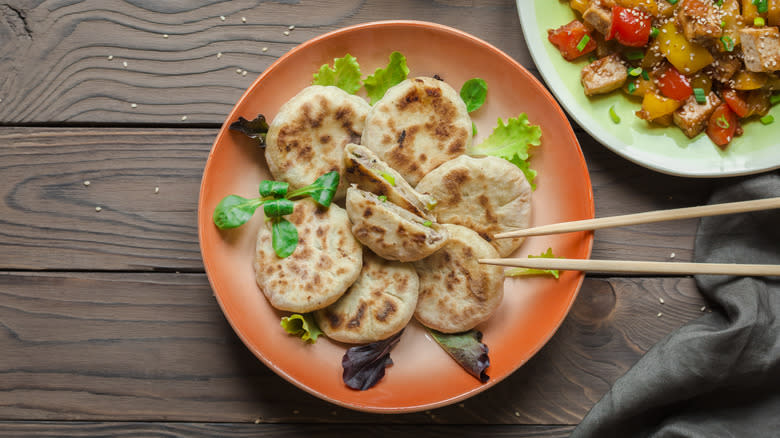
Chinese meat pies, known as xian bing (馅饼), do not require a pan or a mold. Instead, they are flatbreads filled with juicy meat and savory seasonings, shaped by hand, and pan-fried until crispy. Depending on the recipe, the results may be more like flat, super-sized dumplings rather than flatbread, but in all cases, the dough is deliciously chewy with a hint of a crunch on the outside.
For those who love Chinese food, xian bing hit the spot, providing a combination of familiar flavors that knock it out of the park every time. Juicy, succulent ground pork is mixed with scallions, soy sauce, sesame oil, and brown sugar to provide a fragrant, slightly sweet, umami-rich flavor. For added warmth, some recipes also include fresh ginger. Most variations contain a blend of spices, such as white pepper and Sichuan pepper for added heat. The dough is relatively simple, made with only flour, water, oil, and salt.
One aspect of xian bing that differs from other meat pies is that the filling is not pre-cooked. To avoid ending up with raw pork, make sure to flatten the filled dough and leave the pies in the pan for several minutes. The best way to achieve this without burning the outside is to fry them on low heat and cover them once they are browned on both sides.
Timballo/timpano (Italy)
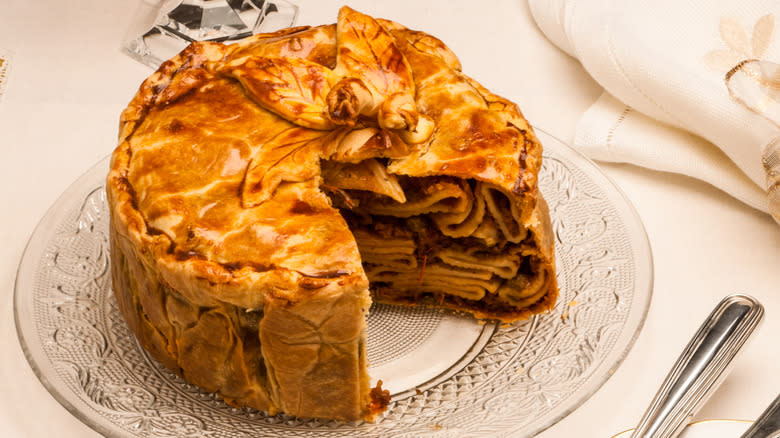
There are many different reasons you might love a particular recipe. There are the recipes that are quick and delicious, the indulgent ones, and the ones that you keep on standby for dinner parties. Then there are the painstaking showstoppers, the one or two recipes that you only bust out on the most special occasions. Timballo falls into the last category. If you've seen the Stanley Tucci movie "Big Night," you'll know what it is: a giant pie crust or sheet of pasta dough filled with ragú, pasta, meatballs, sausage, cheese, eggs, and veggies.
Making timballo (also called timpano in some regions) can take days, and the ingredients will fill an entire shopping cart. Ideally, the finished product should be about as high as it is wide, a task that even the most skilled chefs struggle to execute. Luckily, as long as you have a clearly written recipe, the process is otherwise straightforward. All you need is plenty of time and a methodical approach.
Steak And Kidney Pie (U.K.)
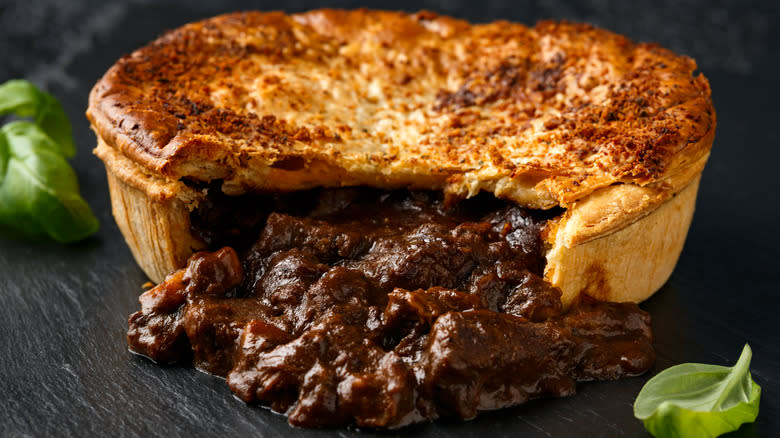
Visit almost any traditional pub in England and you'll find steak and kidney pie on the menu, especially during the winter. Made with buttery crust, beef, vegetables, and kidneys, it's rich, flavorful, and charmingly old-fashioned. Americans are much less accustomed to cooking with kidneys than the Brits are. At first glance, you might regret the decision to cook with them altogether, but do not despair: when baked into a dish with beef, their pungent, slightly sour, and even metallic taste becomes more seasoning than a dominant flavor.
One of the most consequential steps in making steak and kidney pie is where you procure the kidneys. The role of kidneys in the body is to remove toxins from the blood and convert the waste into urine. While we're not saying that they taste like urine exactly, it's an unfortunate truth that low-quality kidney meat can come off as a bit rancid. When buying them, opt for whole rather than pre-cut kidneys and look for options that still have a layer of fat. This suggests minimal processing. Take into consideration what sort of animal supplied the meat, too. Veal and lamb kidneys have the most subtle flavor, while ox kidneys are more likely to be pungent. For steak and kidney pie, ox kidneys will suffice. The rest of the filling is bursting with strong flavors such as Dijon mustard, Worcestershire sauce, stout beer, and beef chuck, all of which balance the sharpness of the kidneys.
Patties (Jamaica)
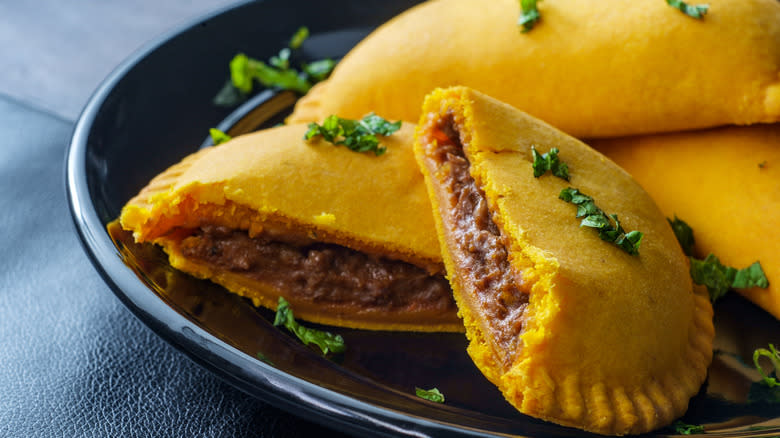
Just as the Argentinians have empanadas and the English have Cornish pasties, Jamaicans have patties -- hand-held pastries filled with a spiced, meaty filling usually centered around beef. Unlike other similar pastries, however, Jamaican patties are yellow. The vibrant color is the result of turmeric and Jamaican curry spice, both of which add to the flavor as well as the appearance.
Another factor you should know before biting into one of these mouthwatering patties is that they traditionally contain the infamous Scotch bonnet pepper (otherwise known as the pepper you need for jerk chicken), which has a Scoville scale rating of 100,000 to 350,000. For context, that's about 40 times hotter than a jalapeño. If you're lucky enough to live near a Jamaican restaurant, you'll likely find beef patties on the menu. If you don't however, you can make them at home. Scotch bonnet peppers are widely available in Caribbean markets, but you can replace them with habanero peppers if necessary.
Piroshky (Ukraine)
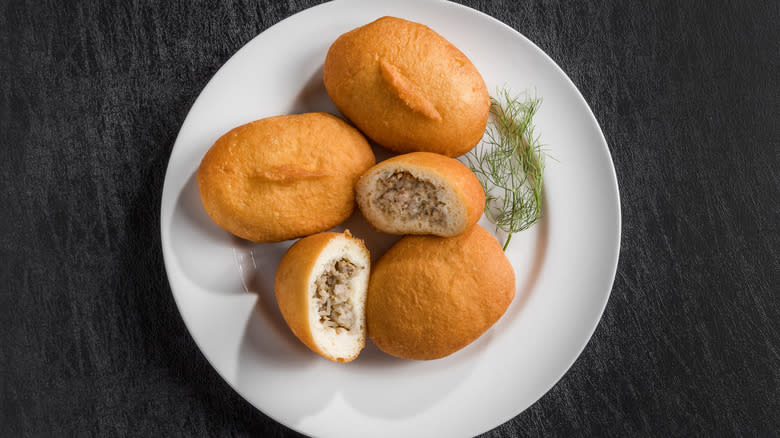
Ukrainian piroshky combine the bready meatiness of a hamburger with the air-tightness of a pie and the creaminess and flavor of a hearty winter stew. In other words, they are delicious. Made by filling bread dough with a meat and vegetable mixture before shaping it into buns and baking it, piroshky are soft, juicy, and highly adaptable. They are popular throughout Eastern Europe and are even a staple of fast food restaurants in Kazakhstan, Kyrgyzstan, and Mongolia, but Ukraine has an extensive and multi-faceted relationship with the hand pies. During World War II, piroshky were not only one of the few foods available, but were also used to smuggle messages between troops and sabotage enemies. Different fillings had coded meanings and were even occasionally laced with poison. Today, they remain a symbol of resistance and national unity.
If you're not too concerned about accidentally sending a coded message, you can get creative with the fillings. For a traditional option, use beef, sautéd cabbage, mashed potatoes, and mushrooms. For a decadent variation on a gourmet sandwich, opt for bacon, cheese, and chicken. You can even make them with a sweet filling, such as stewed apples and sugar.
Pâté En Croûte (France)
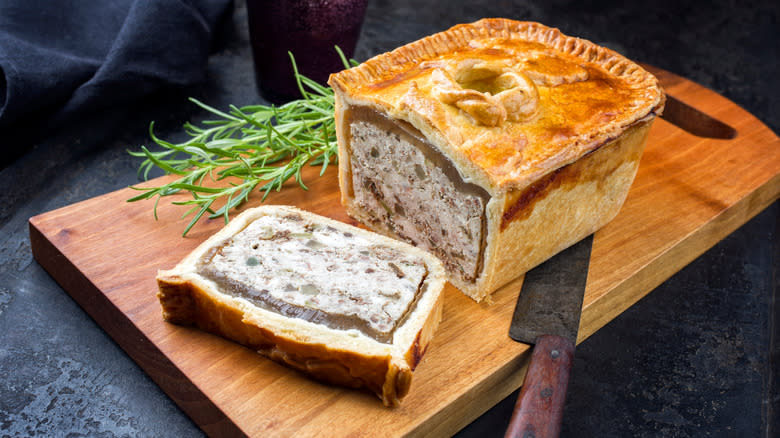
Meat pies usually involve meat that has been shredded, diced, or ground. In the case of pâté en croûte, however, the meat is pâté, a finely blended mixture of meat and flavorful ingredients like dried fruit, nuts, herbs, spices, and vegetables. In order to bind the mixture together, recipes often call for eggs, dairy, and breadcrumbs. Foie gras is another common ingredient. The pastry is usually butter-based but sturdy enough to stand on its own once removed from the mold. As if that weren't enough steps, pâté en croûte requires the use of aspic, a gelatin-based savory jelly. When the pie bakes, the meat shrinks away from the pastry, leaving a gap. Once it's out of the oven, the aspic is poured into small cutouts in the crust to fill the space.
To put it mildly, pâté en croûte is not for the faint of heart. Devilishly tricky to make and full to bursting with rich (and expensive) ingredients, it's the type of recipe you'll probably only make once or twice, or at least only on very special occasions. If you're looking for a challenge, however, it is one of the best out there, especially if you're throwing a fancy party for meat lovers.
Pastel De Choclo (Chile)
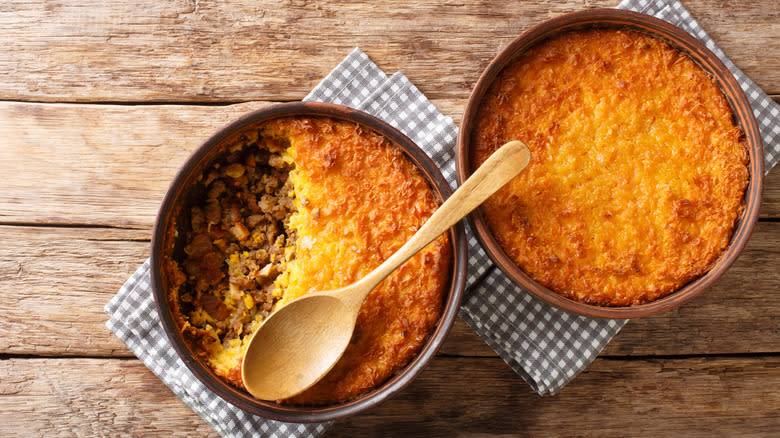
The most widely known South American savory pie is indisputably the empanada, but Chile has its own take on the category – pastel de choclo. More akin to shepherd's pie than a hand pie, pastel de choclo has a ground beef and chicken filling covered in a thick layer of corn pudding. The result is similar to Moroccan b'stilla in that it contains both sweet and savory elements in a surprisingly harmonious package.
The filling includes more than just meat. Onions, garlic, paprika, and cumin are usually involved, as are the unexpected flavors of raisins and black olives. Many recipes also include hard-boiled eggs. The crust can made in multiple ways. Traditionally, it is made with Chilean corn, which is fatter and has a richer flavor and texture than the kind that is most prevalent in the U.S. Some recipes call for a flourless mixture of fresh corn mixed with cream and butter, while others call for the addition of cornmeal. A more transformative option is to include sweetness in the form of condensed milk.
Stargazy Pie (England)
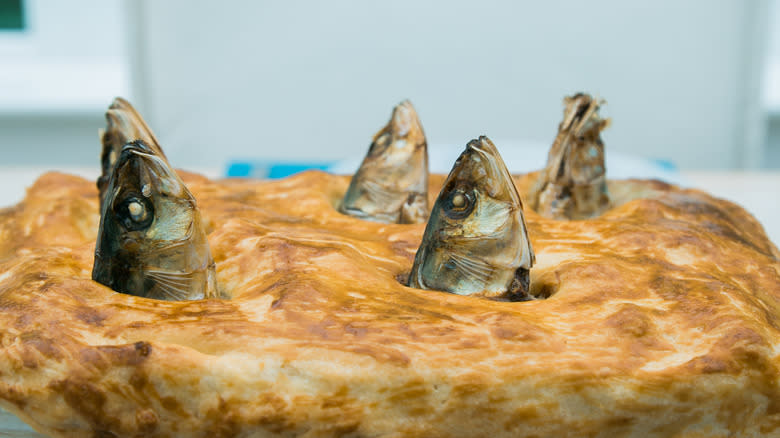
When it comes to the aesthetics of a dish, most cooks aim to entice the eater. At the very least, the goal is to provide an accurate visual representation of what one can expect to taste once they take their first bite. But stargazy pie takes a counterintuitive approach, creating a presentation that is neither particularly appetizing nor very indicative of what's inside. That's because the deliciously creamy bacon pie features whole sardines poking their heads starward out of the crust, eyes and all. Yet, while you will taste the brininess of the fish, the heads are not meant to be eaten.
Stargazy pie is deeply engrained in the culture of Cornwall, the southwesternmost part of the English coastline. According to legend, this dish was created out of necessity when raging winter storms made Cornwall inaccessible to the rest of the country. Gripped by hunger, the locals were granted reprieve by the ingenuity of one of their own, a fisherman named Tom Bowcock, who weathered the tumultuous seas and turned the fruits of his labor into stargazy pie. The region now celebrates his efforts every year on December 23, known as Tom Bowcock's Eve.
Read the original article on Mashed

